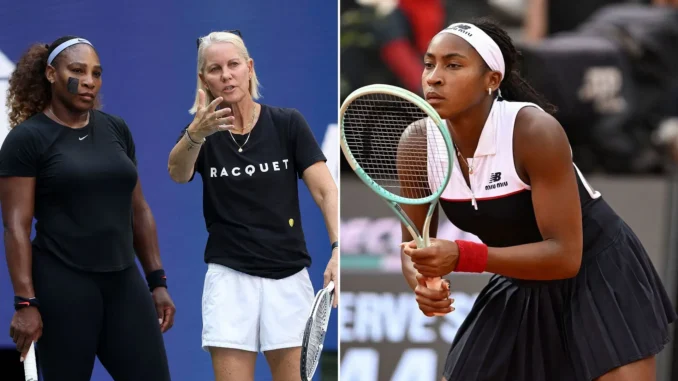
As Coco Gauff prepares for her sixth appearance at the French Open in 2025, she finds herself at a pivotal moment in her burgeoning career. The young American tennis star, currently ranked World No. 2, has shown remarkable prowess on the clay courts this season, reaching the finals of both the Madrid Open and the Italian Open. Yet, despite these achievements, she fell short of clinching the titles, with her serve proving to be a persistent Achilles’ heel. Serena Williams’ former coach, Rennae Stubbs, has pinpointed a critical adjustment that could transform Gauff’s performance at Roland Garros, offering advice that might just propel her to her first clay-court Grand Slam title.
Gauff’s clay season has been nothing short of impressive. Her powerful groundstrokes and exceptional movement have positioned her as a formidable contender. However, her serve, particularly her second serve, has been a recurring issue. In the Italian Open final against Jasmine Paolini, Gauff committed seven double faults and a staggering 55 unforced errors, which ultimately cost her the match. This performance echoed earlier struggles, such as her loss in the Madrid Open final, where her serve faltered under pressure. Stubbs, a former doubles World No. 1 and a seasoned coach who guided Serena Williams during the twilight of her career, has been vocal about Gauff’s potential and the technical tweaks needed to unlock it.
On a recent episode of her podcast, Stubbs delved into the mechanics of Gauff’s serve, identifying a key flaw in her service motion. “If you look at her service motion, Coco goes onto her front leg as she tosses the ball. There’s nowhere to go from there,” Stubbs explained. She noted that this forward shift onto her front left foot restricts Gauff’s ability to generate the necessary spin or power for an effective serve, particularly the three-quarter serve that is crucial at the elite level. “The fact she quickly shifts onto her front left foot makes it tough to get under the ball or generate the necessary spin,” Stubbs elaborated, emphasizing that this limitation hinders Gauff’s ability to compete consistently against top players.
Stubbs’ advice is not just about mechanics; it’s about building confidence through technical precision. She believes that by refining her service motion—specifically, by holding back on the forward motion before the ball toss—Gauff could significantly reduce her double faults. This adjustment could be the key to maintaining control in high-pressure situations, where Gauff’s serve has often crumbled. Stubbs has previously suggested that if Gauff can keep her double faults below six per match, her chances of winning tournaments, including the French Open, increase dramatically. This insight is particularly relevant given Gauff’s history of high double-fault counts, such as the 21 she committed in a single match against Aryna Sabalenka at the 2024 Wuhan Open.
Despite these challenges, Gauff’s recent performances offer plenty of reasons for optimism. Her back-to-back WTA 1000 finals appearances this clay season signal a growing comfort on the surface, where she reached the French Open final in 2022, only to be outplayed by Iga Swiatek’s clay-court mastery. This year, however, the dynamics have shifted. Swiatek, the defending champion, has shown signs of vulnerability on clay, while Gauff’s confidence is soaring. Her ability to dig deep, as demonstrated in a grueling three-and-a-half-hour Italian Open semifinal win against Qinwen Zheng, showcases her resilience and net play, which Stubbs attributes to Gauff’s experience in doubles.
Stubbs’ faith in Gauff extends beyond technical advice. She has consistently praised the 21-year-old’s work ethic and mental fortitude, qualities that have drawn comparisons to a young Serena Williams. Gauff’s recent success, including her WTA Finals victory in 2024 and her MVP performance at the United Cup, underscores her potential to dominate. As she gears up for Roland Garros, where the main draws will be announced on May 22, 2025, Gauff is poised to capitalize on her clay-court momentum. With Stubbs’ guidance on refining her serve, Gauff could finally overcome her past semifinal and final heartbreaks at the French Open and claim the coveted title.
# Coco Gauff’s French Open 2025 Preparation Guide
## Key Technical Adjustment
– **Service Motion Fix**: Rennae Stubbs recommends that Coco Gauff adjust her service motion by avoiding a premature shift onto her front left foot during the ball toss. This tweak can help generate better spin and power, reducing double faults and improving serve consistency.
## Strategic Focus
– **Reduce Double Faults**: Aim to keep double faults below six per match to maintain control and boost confidence, as advised by Stubbs.
– **Leverage Clay-Court Strengths**: Capitalize on strong groundstrokes and exceptional movement, honed through recent WTA 1000 finals appearances.
– **Net Play Proficiency**: Continue leveraging doubles experience to enhance net play, as demonstrated in the Italian Open semifinal against Qinwen Zheng.
## Mental Preparation
– **Build Confidence**: Use recent successes, like the WTA Finals and United Cup MVP award, to fuel belief in her ability to compete against top players like Iga Swiatek.
– **Resilience Under Pressure**: Focus on maintaining composure, drawing on past experiences in high-stakes matches like the 2022 French Open final.
## Tournament Outlook
– **Opportunity on Clay**: With Iga Swiatek showing vulnerabilities, Gauff’s strong clay season positions her as a top contender for the 2025 French Open title.
– **Key Matches**: Prepare for tough competition in Paris, using her improved serve and net play to navigate challenging draws.
Leave a Reply